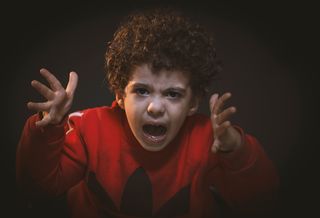Coronavirus Disease 2019
Helping Youth Cope With COVID-19 Disruptions
What can parents do to help?
Posted March 29, 2020
Parents often believe that children are either too young to be aware of what's going on or that talking about the pandemic will upset them needlessly. Should parents initiate conversations or take cues from their children about whether to discuss the coronavirus and why it's affecting daily life?
With schools being closed, it's natural for children to question what's going on. These would be good opportunities to talk with children about why they are staying home. Of course, how much information and detail parents share depends on the age and maturity of the child.
Parents should take cues from their children and consider what information is most pertinent. Children may differ in how many questions they have, and how much they want to know. Start with the simplest answers. See how they respond and go from there. Do they seem satisfied with that answer? Do they have more questions?
For some kids, having more information helps them to process and understand what's happening and to better cope. But for other kids, less information may be better.
This pandemic is something that is mostly uncontrollable. It's helpful to keep that in mind—for adults and children alike. But families can identify things that they do have control over. These include things like social distancing and good hygiene. And parents can explain that it's important to do these things to prevent the spread of germs.

Children may be upset they can't do the things they normally do, such as seeing their friends, playing on the playground, or going to the library or friends' homes. But with technology, parents can help to arrange video chats with friends and relatives or make videos to send back and forth. Also, parents can help children develop a new routine to cope better with the changes—this can provide children a sense of predictability and stability in these unpredictable times. Families can also consider ways to help their local community, such as assisting neighbors and collecting needed items.
What about teens?
There has been a lot of media coverage of people, mostly teens and young adults, not following the social distancing guidelines and gathering in large crowds. The idea that they won't catch the virus or the effects won't be as bad for them can be explained in part by teens' brain development—or lack of development. Specifically, the area of the brain that is involved in decision making, thinking about the future, and managing immediate gratification is not yet fully developed until youth reach about the mid-20s (Gogtay et al., 2004).
So the question becomes: How do we get the message about the importance of social distancing across to young people?

One way may be through their friends. If the young people who are practicing social distancing can reach out and encourage their friends to do the same, this may help to reduce the number of young people dismissing the social distancing guidelines. Friends have a significant influence on one another during the teenage years, especially when it comes to making risky choices (e.g., Albert et al., 2013). If friends can influence risky choices, they can also influence safer choices during this pandemic by modeling and communicating about the importance of social distancing, and why they are following the guidelines.

Another way may be through parents. For teens, parents can help to monitor their teen's whereabouts and also have conversations about what's happening. Parents can monitor what kind of information teens are receiving and the source of that information to help correct misinformation and process the news together. Parents can also provide teens with credible information about the pandemic and how to prevent the continued spread of the virus. This can help reinforce messages about following recommended guidelines.
There have been instances of race-related bullying associated with blaming rhetoric about the virus's origins in China. How might parents allay children's fears or anger and turn these incidents into teachable moments?
Monitoring what children and teens are seeing and where they are getting information can help parents manage the messages that their children are getting. For families with younger children, it might be helpful for parents to first process information from various news outlets themselves, rather than viewing or reading information with young children. This will give parents time to decide what to share and how they want to share it.
Children are impressionable and learn from the actions of their parents and other close adults. And of course, parents are models for teens as well. To prevent the perpetuation of race-related bullying and blaming, it's not something that can be ignored.

Teaching kids to be "colorblind" and not talking about race and experiences of inequality or racism faced by racial and ethnic minority groups can feed into the problem (find more information here). Research in this area shows that when we ignore the facts and reality of what's happening, it could potentially add to the perpetuation of racism and discrimination and also undermines the experiences and history of individuals from racial and ethnic minority backgrounds (Rogers & Meltzoff, 2017).
Parents can use this as a teachable moment by acknowledging unfair treatment and misplaced blame and provide credible information that reiterates the fact that germs are not spread based upon one's race or ethnicity.
What are the signs that a child is becoming stressed, and how might parents respond?
Signs that a child might be stressed or anxious include:
- Acting out (more than normal)
- Becoming withdrawn
- Directly expressing stress or anxiety

Parents can regularly check in with their children and try to be supportive by validating their children's feelings and experiences. These are incredibly difficult and overwhelming times for everyone, and parents don't have to feel like they have the answers, nor should they expect that they can immediately make things better for their children. But being there for one another and listening to one another when a family member is feeling particularly down or distressed can still make a difference.
With social distancing, the disruption to children and teens' normal routines may be difficult. In addition to checking in with their kids, parents can directly ask how they can help, or try to make some suggestions to help in the short term (e.g., doing an activity/game together for distraction). And with spring upon us, trying to get outdoors will allow for a change of scenery and fresh air that could lift everyone's spirits. Although these are unprecedented times, families can try to make the best of this situation by spending time together and reconnecting.
What might parents do if they're feeling unsure about the support or answers they're providing to their children?
It's important to recognize that parents are also dealing with the challenges that coronavirus has presented—with work and home lives colliding. Parents may have their own stress and concerns that are made worse by this pandemic, especially low-income families who may have relied on resources from the child's school, such as meals.
It's important to remind ourselves that everyone is trying to make the best of an incredibly difficult situation—and for parents to remember they are doing their best, even if it doesn't always feel like it.
Some parents may not have the flexibility or resources to implement some of these suggestions in this article, and that's OK. They don't need to put added pressure on themselves to have all the answers.
Parents can acknowledge the challenges and let their children know that they are also figuring out how to cope with this ever-changing situation themselves, and involving kids in the process can help them learn from this, too.
This is an edited version of an interview I gave to the University of Illinois News Bureau.
References
Albert, D., Chein, J., & Steinberg, L. (2013). The teenage brain: Peer influences on adolescent decision making. Current Directions in Psychological Science, 22(2), 114-120.
Gogtay, N., Giedd, J. N., Lusk, L., Hayashi, K. M., Greenstein, D., Vaituzis, A. C., ... & Rapoport, J. L. (2004). Dynamic mapping of human cortical development during childhood through early adulthood. Proceedings of the National Academy of Sciences, 101(21), 8174-8179.
Rogers, L. O., & Meltzoff, A. N. (2017). Is gender more important and meaningful than race? An analysis of racial and gender identity among Black, White, and mixed-race children. Cultural Diversity and Ethnic Minority Psychology, 23(3), 323.




